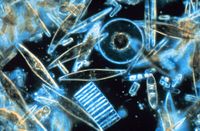
Photo from wikipedia
Functional diversification following gene duplication is one of the major driving forces of protein evolution. While the role of nonsynonymous substitutions in the functional diversification of proteins is well recognized,… Click to show full abstract
Functional diversification following gene duplication is one of the major driving forces of protein evolution. While the role of nonsynonymous substitutions in the functional diversification of proteins is well recognized, knowledge of the role of synonymous substitutions in protein evolution is in its infancy. ABSTRACT Ammonium transporters are present in all three domains of life. They have undergone extensive horizontal gene transfer (HGT), gene duplication, and functional diversification and therefore offer an excellent paradigm to study protein evolution. We attempted to complement a mep1Δmep2Δmep3Δ strain of Saccharomyces cerevisiae (triple-deletion strain), which otherwise cannot grow on ammonium as a sole nitrogen source at concentrations of <3 mM, with amtA of Dictyostelium discoideum, an orthologue of S. cerevisiae MEP2. We observed that amtA did not complement the triple-deletion strain of S. cerevisiae for growth on low-ammonium medium. We isolated two mutant derivatives of amtA (amtA M1 and amtA M2) from a PCR-generated mutant plasmid library that complemented the triple-deletion strain of S. cerevisiae. amtA M1 bears three nonsynonymous and two synonymous substitutions, which are necessary for its functionality. amtA M2 bears two nonsynonymous substitutions and one synonymous substitution, all of which are necessary for functionality. Interestingly, AmtA M1 transports ammonium but does not confer methylamine toxicity, while AmtA M2 transports ammonium and confers methylamine toxicity, demonstrating functional diversification. Preliminary biochemical analyses indicated that the mutants differ in their conformations as well as their mechanisms of ammonium transport. These intriguing results clearly point out that protein evolution cannot be fathomed by studying nonsynonymous and synonymous substitutions in isolation. The above-described observations have significant implications for various facets of biological processes and are discussed in detail. IMPORTANCE Functional diversification following gene duplication is one of the major driving forces of protein evolution. While the role of nonsynonymous substitutions in the functional diversification of proteins is well recognized, knowledge of the role of synonymous substitutions in protein evolution is in its infancy. Using functional complementation, we isolated two functional alleles of the D. discoideum ammonium transporter gene (amtA), which otherwise does not function in S. cerevisiae as an ammonium transporters. One of them is an ammonium transporter, while the other is an ammonium transporter that also confers methylammonium (ammonium analogue) toxicity, suggesting functional diversification. Surprisingly, both alleles require a combination of synonymous and nonsynonymous substitutions for their functionality. These results bring out a hitherto-unknown pathway of protein evolution and pave the way for not only understanding protein evolution but also interpreting single nucleotide polymorphisms (SNPs).
Journal Title: Microbiology Spectrum
Year Published: 2023
Link to full text (if available)
Share on Social Media: Sign Up to like & get
recommendations!